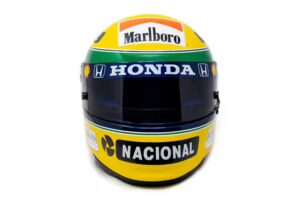An Icon’s Relic Shatters Motorsport Memorabilia Records, Cementing Senna’s Eternal Grip on Racing Legacy
In the high-octane world of motorsport collectibles, few objects carry the metaphysical heft of a Formula 1 driver’s helmet. It is not merely a piece of protective equipment; it is both armor and altar. In this space, the helmet becomes sacred—sweat-soaked, carbon-fiber testament to human precision at unfathomable speeds. On April 28, 2025, one such object—Ayrton Senna’s race-worn helmet from the 1992 Formula 1 season—crossed the threshold from artifact to myth, selling at auction for a staggering $963,700 USD, setting a new world record for the most expensive F1 helmet ever sold.
This sale, conducted through RM Sotheby’s in Monaco, eclipsed the previous benchmark nearly threefold: Charles Leclerc’s 2023 Monaco Grand Prix helmet, which fetched approximately $300,000. The result is not simply an escalation of value but a statement of reverence. In the realm of collectibles, it’s not always about scarcity—it’s about significance. And no name in motorsport echoes quite like Senna.
The Helmet That Held History
The 1992 helmet in question is a vivid object—iconic in its canary yellow base, intersected by green and blue stripes echoing the Brazilian flag. Designed by Sid Mosca, Senna’s longtime helmet artist, this particular model was worn during one of Senna’s more turbulent seasons at McLaren-Honda, a time when his dominance was being tested, but not dimmed. Though the championship went to Nigel Mansell that year, Senna’s relentless drive and on-track artistry remained unshakable.
The helmet bears visible race patina, including stone chips, visor scratches, and internal padding indentations—marks of battle from circuits such as Monaco, Interlagos, and Spa. It is autographed by Senna on the crown, sealed beneath the lacquer in his unmistakable script, a final personal touch from a driver who rarely spoke in grand flourishes, but always in truth.
What makes this helmet transcendent is its provenance. Documented as race-used and team-issued, its lineage is as ironclad as its shell. Stored with care, verified by McLaren’s own heritage division, and accompanied by extensive documentation, the helmet’s authenticity is beyond reproach. It is not simply memorabilia—it is an heirloom of speed.
Why Senna Still Commands the Highest Price
In the thirty-one years since his death at Imola in 1994, Ayrton Senna has not faded—he has intensified. His legacy transcends results, podiums, and even sport. Senna represents an idea of greatness, a moral force behind the wheel. He drove not only with technical mastery, but with a sense of cosmic conviction, as if ordained to race.
The fact that Senna’s helmet now holds the record price is not an anomaly—it’s a correction. In recent years, the auction world has seen a rising tide of F1 memorabilia sales, but few with the emotional or cultural resonance of this piece. While Leclerc’s 2023 helmet marked a home race milestone, Senna’s helmet marks a universal symbol: the soul of F1 itself.
Collectors understand this. When they bid on Senna, they are not buying fame. They are acquiring a link to the most revered spirit in motor racing history. It’s no coincidence that TAG Heuer, McLaren, and even Hollywood filmmakers continue to orbit around his aura. Senna is not merely remembered—he is worshipped.
The Auction Environment: F1 Memorabilia’s New Era
The auction took place during RM Sotheby’s biennial Monaco sale, an event that traditionally gathers the world’s wealthiest racing enthusiasts and collectors during the week of the Monaco Grand Prix. Here, vintage Ferraris, archival racing suits, and track-used ephemera pass hands with prices that mirror the velocity of the sport itself.
Yet even among a room full of automotive icons, Senna’s helmet stood alone. Bidding opened at $300,000—a price many anticipated would be the ceiling. But within minutes, bidders on the phone, online, and present in the room drove the figure skyward in fierce increments. By the ten-minute mark, the bidding had surpassed $750,000. When the final gavel landed at $963,700, the crowd responded not with shock—but with awe.
Auction analysts believe the sale may signify a tipping point in F1 collecting, where items related to legends of the 1980s and 1990s are beginning to command the kind of reverence long reserved for 1950s Le Mans or 1960s Ferrari relics.
A Season of Senna: Cultural Timing and Renewed Fascination
The timing of the helmet’s sale was not incidental. 2024 marked the 30th anniversary of Senna’s passing, leading to a wave of retrospectives, documentaries, and tributes. McLaren unveiled a Senna Edition livery in Monaco. Netflix commissioned a dramatized biopic series produced by Brazilian filmmakers, introducing younger generations to the depth of his persona. The marketplace, in turn, responded with fevered interest.
But beyond marketing cycles, there is something deeper occurring—a longing. In a modern F1 landscape dominated by data, hybrid engines, and polished media personas, Senna represents a purer, more visceral age. He spoke of racing as a spiritual act. His duels with Alain Prost, his rain-soaked performances, his philosophical interviews—they resonate as truth, not theatre.
This cultural sentiment converts to market behavior. Collectors don’t simply want a piece of Senna—they want what he stood for: authenticity, purpose, danger, and grace.
Comparing Legacy and Value: Senna vs Leclerc
Charles Leclerc, Ferrari’s golden son, is the closest modern F1 has to a native Monegasque hero. His 2023 helmet, worn during a hometown podium finish, was a deeply emotional artifact. But its sale price—just over $300,000—now seems quaint by comparison.
Why the disparity?
It is, in part, a matter of historical weight. Leclerc’s helmet was a moment; Senna’s is a myth. Leclerc may one day join the pantheon, but Senna built it. In market terms, Senna’s memorabilia occupies the same realm as Muhammad Ali gloves or Michael Jordan’s rookie sneakers—items that carry not just provenance but pantheonic reverence.
Moreover, the emotional texture of Senna’s death—in real time, in front of millions, in the prime of his greatness—adds a tragic gravity. His relics are limited not by scarcity alone, but by finality. Every helmet that surfaces is one of the last. Every signature, every smudge, carries the weight of an unfinished symphony.
The Helmet as Icon: Why This Object Endures
Among all motorsport memorabilia, the helmet retains a unique status. A race suit is mutable, interchangeable. A car is communal, touched by engineers and pit crews. But a helmet is intimate. It sits against the skin. It absorbs breath, fear, calculation. It is a second skull.
Senna’s 1992 helmet, in particular, carries dual symbolism. It was worn during a transitional moment—when Senna was fighting against the technological tide, holding back the rise of driver aids and electronic control systems that threatened to dilute the human element of the sport. His helmet, then, is not just a safety device—it is a protest, a relic of human supremacy against machine inevitability.
Its current display, soon to be enshrined in a private collection or museum, does not dim its power. It speaks to everyone who ever believed that the driver mattered more than the data.
Beyond the Gavel: The Future of F1 Collecting
As Formula 1 expands globally—with races in Las Vegas, Miami, Saudi Arabia, and more—its fanbase is evolving, too. New collectors are emerging from wealth sectors previously untouched by classic European car culture. Celebrities, tech moguls, athletes—all are entering the memorabilia space, seeking objects that represent not just investment, but identity.
Senna’s helmet now becomes a benchmark. It raises the ceiling for future auctions of Schumacher suits, Hamilton gloves, Verstappen steering wheels. But it also draws a line in the sand: no matter how shiny the future gets, the heart of F1 still beats in the past.
Impression: A Symbol Beyond Time
$963,700 is a number. But the true value of Ayrton Senna’s helmet cannot be counted in currency alone. It is a vessel of memory. A mirror of greatness. A talisman for what sport at its highest level can evoke: awe, sacrifice, transcendence.
In a world increasingly mediated by screens and simulations, there’s something profoundly human about the way a used helmet can quiet a room, ignite a bidding war, and bring grown men to tears. Senna may have raced decades ago, but his legacy is not a rearview phenomenon. It continues to accelerate.
Because some stories don’t age—they endure.
No comments yet.









